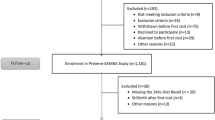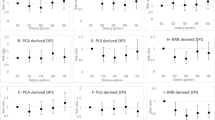Abstract
Objective:
The aim of this study is to obtain distinct dietary patterns using principal components analysis (PCA) in men taking part in the Avon Longitudinal Study of Parents and Children and to determine the associations with (a) the patterns derived in the study women (the men's partners), (b) socio-demographic and lifestyle factors and (c) estimated nutrient intakes.
Design and methods:
A total of 4681 men taking part in a population-based cohort study recorded their current frequency of food consumption through questionnaire. Dietary patterns were identified using PCA, and scores were calculated for each pattern. A wide variety of social and demographic characteristics and lifestyle factors were also collected through self-completion questionnaire.
Results:
Four dietary patterns were established: ‘health conscious’, ‘traditional’, ‘processed/confectionery’ and ‘semi-vegetarian’. There were relatively strong correlations and levels of agreement between the ‘health conscious’ and ‘vegetarian’ style patterns in men and women (P<0.001). Strong associations were evident between several socio-demographic variables and the dietary patterns, similar to those earlier reported in women. Finally, nutrient intakes were plausibly associated with dietary pattern scores.
Conclusions:
Distinct dietary patterns in men have been identified using PCA that are similar, but not identical to those obtained in their partners at the same time point. Researchers should always consider stratifying by gender when examining dietary patterns. This study will form the basis for further work investigating the associations between parental and child dietary patterns.
This is a preview of subscription content, access via your institution
Access options
Subscribe to this journal
Receive 12 print issues and online access
$259.00 per year
only $21.58 per issue
Buy this article
- Purchase on Springer Link
- Instant access to full article PDF
Prices may be subject to local taxes which are calculated during checkout
Similar content being viewed by others
References
Barker ME, McClean SI, Thompson KA, Reid NG (1990). Dietary behaviours and sociocultural demographics in Northern Ireland. Brit J Nutr 64, 319–329.
Beaudry M, Galibois I, Chaumette P (1998). Dietary patterns of adults in Quebec and their nutritional adequacy. Can J Pub Health 89, 347–351.
Bland M (2000). An Introduction to Medical Statistics, 3rd edn, Oxford University Press: Oxford.
Cattell RB (1966). The screen test for the number of factors. Multivariate Behav Res 1, 245–276.
Chakraborti S, Chakraborti T, Mandal M, Mandal A, Das S, Ghosh S (2002). Protective role of magnesium in cardiovascular diseases: a review. Mol Cell Biochem 238, 163–179.
Costacou T, Bamia C, Ferrari P, Riboli E, Trichopoulos D, Trichopoulou A (2003). Tracing the Mediteranean diet through principal components and cluster analyses in the Greek population. Eur J Clin Nutr 57, 1378–1385.
Crozier S, Robinson S, Borland S, Inskip H, Southampton Women's Study Group (2006). Dietary patterns in the Southampton Women's Survey. Eur J Clin Nutr 60, 1391–1399.
Golding J, Pembrey M, Jones R, the ALSPAC Study Team (2001). ALSPAC-The Avon Longitudinal Study of Parents and Children. I. Study methodology. Paediatr Perinat Epidemiol 15, 74–87.
Gorsuch RL (1974). Factor Analyses. WB Saunders: Philadelphia, PA.
Gregory J, Foster K, Tyler H, Wiseman M (1990). Classification and types of diet. In The Dietary and Nutritional Survey of British Adults. Office of Population Censuses and Surveys, chapter 13, pp 209–215. HMSO: London.
Hu FB, Rimm E, Smith-Warner SA, Feskanich MJ, Stampfer MJ, Ascherio A et al. (1990). Reproducibilty and validity of dietary patterns assessed with a food-frequency questionnaire. Am J Clin Nutr 69, 243–249.
Kesse-Guyot E, Bertrais S, Peneau S, Estaquio C, Dauchet L, Vergnaud A-C et al. (2008). Dietary patterns and their sociodemographic and behavioural correlates in French middle-aged adults from the SU.VI.MAX cohort. Eur J Clin Nutr 63, 521–528.
Kline P (1994). An Easy Guide to Factor Analysis. Routledge: London.
Lau C, Glumer C, Toft U, Tetens I, Carstensen B, Jorgensen T et al. (2007). Identification and reproducibility of dietary patterns in a Danish cohort: the Inter99 study. Br J Nutr 99, 1089–1098.
Mcnaughton SA, Mishra GD, Bramwell G, Paul AA, Wadsworth ME (2005). Comparability of dietary patterns assessed by multiple dietary assessment methods: results from the 1946 British Birth Cohort. Eur J Clin Nutr 59, 341–352.
Mishra GD, Ball K, Arbuckle J, Crawford D (2002). Dietary patterns of Australian adults and their association with socioeconomic status: results from the 1995 National Nutrition Survey. Eur J Clin Nutr 56, 687–693.
Mishra GD, Prynne CJ, Paul AA, Greenberg DC, Bolton-Smith C (2006). The impact of inter-generational social and regional circumstances on dietary intake patterns of British adults: results from the 1946 British Birth Cohort. Br J Nutr 96, 735–744.
Newby PK, Muller D, Hallfrisch J, Andres R, Tucker KL (2004). Food patterns measured by factor analysis and anthropometric changes in adults. Am J Clin Nutr 80, 504–513.
North K, Emmett P, the ALSPAC Study Team (2000). Multivariate analysis of diet among three-year old children and associations with socio-demographic characteristics. Eur J Clin Nutr 54, 73–80.
Northstone K (2008). Dietary patterns obtained using principal components analysis in the mothers and children from the Avon Longitudinal Study of Parents and Children. PhD Thesis, University of Bristol.
Northstone K, Emmett P, the ALSPAC Study Team (2005). Multivariate analysis of diet in children at four and seven years of age and associations with socio-demographic characteristics. Eur J Clin Nutr 59, 751–760.
Northstone K, Emmett P, Rogers I (2008). Dietary patterns in pregnancy and associations with socio-demographic and lifestyle factors. Eur J Clin Nutr 62, 471–479.
Northstone K, Emmett PM (2008). A comparison of methods to assess changes in dietary patterns from pregnancy to 4 years post-partum obtained using principal components analysis. Br J Nutr 99, 1099–1106.
Rogers I, Emmett P, the ALSPAC Study Team (1998). Diet during pregnancy in a population of pregnant women in South West England. Eur J Clin Nutr 52, 246–250.
Sanchez-Moureno C, Jiminez-Escrig A, Martin A (2009). Stroke: rules of B vitamins; homocysteine and antioxidants. Nutr Res Rev 22, 49–67.
Sanchez-Villegas A, Delgado-Rodriguez M, Martinez-Gonzalez MA, de Irala-Esteves J, for the SUN group (2003). Gender, age, socio-demographic and lifestyle factors associated with major dietary patterns in the Spanish project SUN (Seguimineto Universidad de Navarra). Eur J Clin Nutr 57, 285–292.
Teucher B, Skinner J, Skidmore PML, Cassidy A, Fairweather-Tait SJ, Hooper L et al. (2007). Dietary patterns and heritability of food choice in a UK female twin cohort. Twin Res Hum Genet 10, 734–748.
Voutilainen S, Nurmi T, Mursu J, Rissanen TH (2006). Carotenoids and cardiovascular health. Am J Clin Nutr 83, 1265–1271.
Wichelow MJ, Prevost AT (1996). Dietary patterns and their associations with demographic, lifestyle and health variables in a random sample of British adults. Br J Nutr 76, 17–30.
Willett WC (1989). Nutritional Epidemiology, 2nd edn. Oxford University press: New York.
World Cancer Research Fund/American Institute for Cancer Research (2007). Food, Nutrition, Physical Activity, and the Prevention of Cancer: A Global Perspective. AICR: Washington DC.
Yang EJ, Kerver JM, Song WO (2005). Dietary patterns of Korean Americans described by factor analysis. J Am Coll Nutr 24, 115–121.
Acknowledgements
We are extremely grateful to all the families who took part in this study, the midwives for their help in recruiting them, and the whole ALSPAC team, which includes interviewers, computer and laboratory technicians, clerical workers, research scientists, volunteers, managers, receptionists and nurses. The UK Medical Research Council, the Wellcome Trust and the University of Bristol provide core support for ALSPAC. PME and KN have received financial support from the Arthritic Association. This publication is the work of the authors and KN will serve as guarantor for the contents of this article.
Author information
Authors and Affiliations
Corresponding author
Ethics declarations
Competing interests
The authors declare no conflict of interest.
Additional information
Contributors: KN was responsible for the data analysis and interpretation and drafted the manuscript. PME was responsible for the design and collection of the dietary data and contributed to manuscript preparation. Both authors contributed to the intellectual content and approved the final version of the manuscript.
Rights and permissions
About this article
Cite this article
Northstone, K., Emmett, P. Dietary patterns of men in ALSPAC: associations with socio-demographic and lifestyle characteristics, nutrient intake and comparison with women's dietary patterns. Eur J Clin Nutr 64, 978–986 (2010). https://doi.org/10.1038/ejcn.2010.102
Received:
Revised:
Accepted:
Published:
Issue Date:
DOI: https://doi.org/10.1038/ejcn.2010.102
Keywords
This article is cited by
-
Trajectories of dietary patterns from pregnancy to 12 years post-pregnancy and associated maternal characteristics: evidence from the Avon Longitudinal Study of Parents and Children
European Journal of Nutrition (2023)
-
Shifts towards healthy diets in the US can reduce environmental impacts but would be unaffordable for poorer minorities
Nature Food (2021)
-
Dietary patterns of university students in the UK: a cross-sectional study
Nutrition Journal (2018)
-
Socio-demographic and lifestyle determinants of dietary patterns in French-speaking Switzerland, 2009–2012
BMC Public Health (2018)
-
Dietary advice for muscularity, leanness and weight control in Men’s Health magazine: a content analysis
BMC Public Health (2014)



